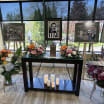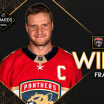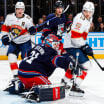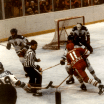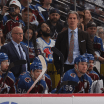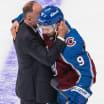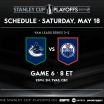BOSTON --There were scenarios in which Sean Kuraly would have had to go away, to Detroit or Cleveland or Pittsburgh, to continue his hockey education, rather than remaining in his hometown, where he arrived at 5 years old after his family moved from Buffalo.
Kuraly goes home with Bruins for Game 3 against Blue Jackets
Forward stayed in growing hockey hotbed of Columbus to learn sport
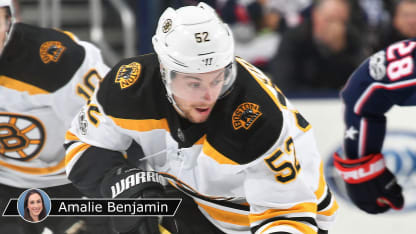
Unlike Buffalo -- or Toronto, where his father, Rick Kuraly, grew up -- Columbus hardly was synonymous with hockey. The home of Ohio State University was a football stronghold, a place where backyard rinks barely lasted a week, and one without the infrastructure to support a kid who might have dreams of playing in the NHL.
RELATED: [Complete Bruins vs. Blue Jackets series coverage]
But a hockey culture was sprouting in Columbus, with a new AAA team, a new NHL team for the 2000-01 season, a way forward without leaving his family. So Kuraly, now a Boston Bruins forward, stayed. He played for the AAA Blue Jackets. He went to Miami University, a two-hour drive west in Oxford, Ohio.
He was selected by the San Jose Sharks in the fifth round (No. 132) of the 2011 NHL Draft, traded to the Boston Bruins in 2015 as part of the Martin Jones trade, and made his NHL debut Nov. 3, 2016.
It all started in Columbus, Ohio. And now he's coming back, as the Eastern Conference Second Round between the Bruins and Blue Jackets shifts to Columbus for Game 3 at Nationwide Arena on Tuesday (7 p.m. ET; NBCSN, CBC, SN, TVAS). The best-of-7 series is tied 1-1.
"It's nuts," said Ed Gingher, coach of the AAA Blue Jackets and one of the people instrumental for the development of hockey in the area. "It's crazy. The term I've used a few times is a perfect storm. All the momentum that the Jackets have right now, and then you throw in the subplot of Sean playing against us. It's surreal."
The list of players who have come out of Columbus remains small and young, and includes Kuraly, 26; Chicago Blackhawks defenseman Connor Murphy, 26; Winnipeg Jets center Jack Roslovic, 22; Anaheim Ducks forward
Kiefer Sherwood
, 24; and his younger brother, Blue Jackets forward
Kole Sherwood
, 22. The list is growing, and one day might rival the contingent coming out of St. Louis, a place that Gingher said he tried to model Columbus hockey after, while acknowledging that St. Louis had a 30-plus year head start.
"That is a great market," Gingher said. "I dealt with the AAA Blues guys. I still do on a regular basis because they have built a program around area kids. It's not a program that nationally recruits. They want to develop local kids and that is still our goal in Columbus.
"To have those opportunities and have area kids be able to grow up in a program and never have to leave and get every opportunity, for us, St. Louis is a great example."
Kuraly, in all likelihood, would have played hockey no matter what. His father starred at Miami University and is the school's all-time leader with 101 goals in four seasons. Rick Kuraly was recruited out of Toronto to Miami by Bill Davidge, a long-time presence in the Ohio hockey scene who would coach Sean on a peewee team in 2004-05. Davidge now is a Blue Jackets analyst on Fox Sports Ohio.
But it would have been harder on Sean, and harder on his family, if he had to leave. Instead he got to grow up in Columbus, develop in Columbus, and now return to Columbus in the midst of the Stanley Cup Playoffs.
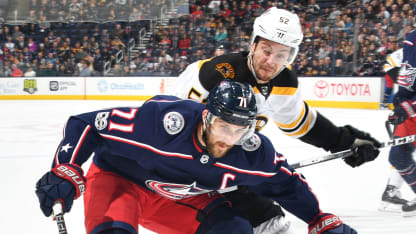
© Jamie Sabau/Getty Images
\\\\
When the Kuraly family moved to Columbus, it was far from a given that Sean would make a life in hockey. He would play, sure. But he was only 5 and he loved soccer and there was time to make any decision that would affect his sports career or his life later on.
So hockey wasn't exactly a concern for Rick.
"I guess he was fortunate," Rick said. "He played up a little bit in Buffalo. But at the time he played house league. There was no AAA Blue Jackets or anything like that. I think A or AA was the highest level they had, but he was still young."
But Sean moved up the ladder, playing on an independent AAA team before the AAA Blue Jackets came to be. There were still significant amounts of travel, because teams from Detroit and Cleveland were less willing to head all the way to Columbus for one opponent.
They got lucky with a team in Pittsburgh, the Hornets, who boasted a talent-laden roster that included J.T. Miller (Tampa Bay Lightning), John Gibson (Ducks) and Vincent Trocheck (Florida Panthers), while the Columbus team had Kuraly and Murphy.
"I think personally I was probably going to play hockey regardless," Sean Kuraly said. "Before I got to Columbus I was going to play. But it's huge. I was at games from the day I could [be], from the day [the Blue Jackets] played their first game until I left to play hockey when I was 17."
He went to the USHL, where he played for the Indiana Ice from 2009-12, and then he enrolled at Miami, just like his dad.
"He had a lot of his dad [in him]," Davidge said. "Sean was a better skater than his dad. But his dad was a better offensive player than Sean. And Sean knew his role and what his ability was, to work his rear end off and that he could earn a job. … Sean was a kid that just never could be denied. He was a competitor. He hated to lose. And he got that from his dad."
There was a moment when Davidge saw Rick again in Sean, as the Bruins forward came down the wing and snapped a one-timer in Game 7 of the Eastern Conference First Round against the Toronto Maple Leafs. As Davidge told Sean, "Just like the old man."
\\\\
When the puck drops for Game 3 in Columbus, Rick Kuraly will be in the stands. His loyalty will, of course, be to his son, but he sees the benefits to the Blue Jackets winning, the chances it might mean for more Columbus kids to play hockey, to see opportunity.
It reflects what he opted to do with Sean.
"He had offers and people were pushing him to go up and play in Detroit just because Columbus was in its infancy," Rick Kuraly said. "But I think [former NHL defenseman and Blue Jackets assistant coach] Gord Murphy and I probably had the same philosophy. We've got three kids and he doesn't need to leave home to do it. If he's good he can play well here and he can still make it, which he did."
TOR@BOS, Gm7: Kuraly pots one top shelf on the rush
Rick wasn't grooming his son for the NHL. But he was giving him an opportunity in a place that was giving more opportunities to more kids at that time.
"I think what you're finding is the more hockey has become top of the mind, those good athletes are looking to play hockey where 10 years ago they may not have," Gingher said. "So that exposure level to a better player has led to obviously a better hockey player.
"A kid like Sean could have left Columbus and he didn't. He stuck with a growing program knowing that he's going to be paving the way."
He grew up on Rick Nash and Jody Shelley, players who would take time to meet and interact with area hockey players, stoke their interest in the sport, knowing it was as important for the growth of the players in the area as the fandom.
It's something the new Columbus generation does now when they come home for the summers, including Sean.
"He's just such a wonderful example for young kids," Gingher said. "I think anywhere, but specifically in Columbus. He's a great person we can point to as a wonderful role model of a kid that just works his rear end off and he gets rewarded for it."
It's kind of like what they've done in Columbus as a whole.
They have worked and developed and introduced kids to hockey. They have found future NHL players and kids who just wanted a diversion and a sport to play. They have watched as the Blue Jackets have endured years of postseason frustration before finally breaking through this season, knocking off the best team in the NHL regular season, the Tampa Bay Lightning, in the Eastern Conference First Round.
"It's come lightyears, a lot quicker than I probably expected," Gingher said. "A lot of it is directly attributed to the Jackets, and I think we're going to see another push just with even the recent success of getting past Round 1, you're going to see a bump. It's exciting. It's been fun to be a part of the ride."
A ride which is not over yet.
"You look at other markets, whether it's Anaheim and L.A., Dallas, even Pittsburgh, where they've had championships," Gingher said. "You've seen what it's done to those markets. I can't wait for that to happen in Columbus. Because it'll just expedite everything that's going on here.
"The Blue Jackets, they've done such a marvelous job of putting their fingerprints all over youth hockey in Columbus that it's going to help every level, and selfishly for the AAA program it's really going to help us. But it's going to impact every level."
It could help kids like Sean Kuraly, who once would have had to leave Columbus, stay and play at home. And then, like Kuraly, get the chance to come back home, this time for a Stanley Cup Playoff game, for the first second-round game to be played in Columbus in Blue Jackets history.
"It's [a chance] for the city of Columbus to take the proverbial next step as a hockey market," Gingher said. "It's really neat when you can see it firsthand and it's tangible. For a young kid coming to watch a game, he's going to see a kid that sat in those seats not that long ago, and all of a sudden he's playing against the Columbus Blue Jackets."
